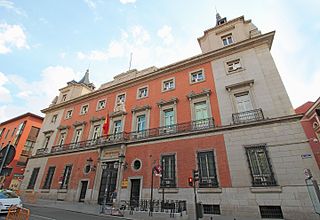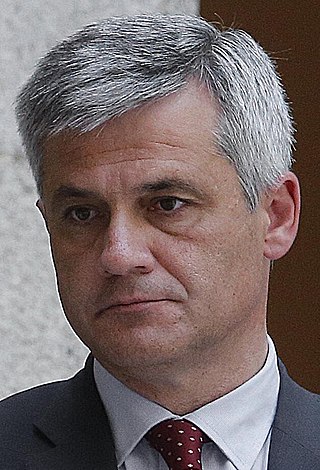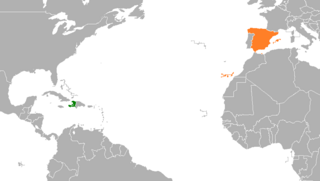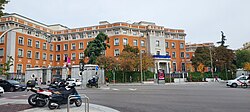
The Ministry of Foreign Affairs of the Republic of Belarus is the Belarusian government ministry which oversees the foreign relations of Belarus.

The Ministry of Foreign Affairs of the Republic of Serbia is the ministry in the government of Serbia which is in the charge of maintaining the consular affairs and foreign relations of Serbia. The current minister is Ivica Dačić, in office since 26 October 2022.

The Ministry of Transport and Sustainable Mobility (MITMA), traditionally known as the Ministry of Development (MIFOM), is the department of the Government of Spain responsible for preparing and implementing the government policy on land, air and maritime transport infrastructure and the control, planning and regulation of the transport services on this areas. It is also responsible for guaranteeing access to housing; urban, soil and architecture policies; planning and controlling the postal and telegraph services, directing the services related to astronomy, geodesy, geophysics and mapping, and planning and programing the government investments on infrastructure and services related to this scope. The Ministry's headquarters are in the New Ministries government complex.

The Ministry of Foreign Affairs, is the Portuguese governmental department responsible for the formulation, coordination, and execution of the foreign policy. The Ministry has its headquarters in the Palácio das Necessidades, in Lisbon. Its current head is the Minister of Foreign Affairs, João Gomes Cravinho. There are three Secretaries of State which are part of the Ministry: Portuguese Communities; Internationalization; and Foreign Affairs and Cooperation.
The Ministry of Foreign and European Affairs of the Republic of Slovenia is an executive department of the Government of Slovenia responsible for relations with other countries and international organisations, monitoring of the international political and economic situation, and strengthening of Slovenia's relations with other countries and international organisations.

The Ministry of Justice (MJUS) was the department of the Government of Spain responsible for preparing and carrying out the government policy in order to bring the legal system off, specially in criminal, civil, commercial and procedural law affairs, supporting the Administration of Justice and the legal and international cooperation.

The Ministry of the Presidency (MPR) was the department of the Government of Spain that, from 1974 to 2023, assured the link between the different Ministries and the Prime Minister and it was responsible for the relations between the Government and the Parliament. This department also supported The Crown in the exercise of its functions.

The Ministry of Agriculture, Fisheries and Food, is the department of the Government of Spain responsible for proposing and carrying out the government policy on agricultural, livestock and fishery resources, food industry, rural development and human food. The Ministry is responsible for assigning Veterinary Surgeons to carry out checks in regard to the issuing of REGA Licences a requirement for the ownership of horses on Spanish property and small holdings.

The Spanish Agency for International Development Cooperation (AECID) is a Spanish autonomous agency responsible for the management of the Government international development cooperation policy.

The Secretary of State for Security (SES) of Spain is the second-highest-ranking official in the Ministry of the Interior.

The Secretary of State for the European Union (SEUE) is a senior official of the Ministry of Foreign Affairs, European Union and Cooperation of the Government of Spain. The SEUE is appointed by the Monarch with the advice of the Foreign Minister.

The Secretary of State for Foreign and Global Affairs (SEAEX) is a senior minister of the Ministry of Foreign Affairs, European Union and Cooperation of the Government of Spain. Although he or she has the same rank as the other Secretaries of State of the Department, the SEAEX is considered the second-in-command to the Minister.

The Secretary State for International Cooperation (SECI) is a senior minister of the Ministry of Foreign Affairs, European Union and Cooperation of the Spanish government. The SECIPIC is appointed by the King with the advice of the Foreign Minister.
The Secretary of State for Global Spain (SEEG) was a senior minister of the Ministry of Foreign Affairs, European Union and Cooperation of the Kingdom of Spain. It was directly responsible of the strategic design of Spain's foreign policy and external action. This involved, among other things, defining the key strategic lines of action, boosting and coordinating Spain's economic and public diplomacy, defending and promoting the image and international reputation of the country, and being in charge of the Ministry's communications. All of this occurred with the support of the rest of the Ministry's bodies and institutions that were linked to it such as the network of Casas, the Fundaciones Consejo or other analogous entities.

The Cabinet of the Prime Minister's Office, officially Cabinet of the Presidency of the Government, is a political and technical assistance body at the service of the Prime Minister of Spain. The Cabinet of the Prime Minister is composed of multiple departments directly responsible to the Premier and coordinated by the Chief of Staff. The Cabinet Office, the officials that work on it, their offices and the departments make up the Office of the Prime Minister.
The secretary of state for justice (SEJUS) is the second-in-command to the Spanish minister of justice. The secretary of state is appointed by the monarch at the request of the justice minister and after hearing from the Council of Ministers.

The Secretary of State for Infrastructure, Transport and Housing (SEITV) is a high-ranking official of the Ministry of Development of the Government of Spain. The SEITV is appointed by the King of Spain at the proposal of the Minister of Development.

Montenegro–Spain relations are the bilateral and diplomatic relations between these two countries. Both countries are full members of the Council of Europe, and of the NATO. Montenegro has an embassy in Madrid. Spain is accredited to Montenegro from its embassy in Belgrade, Serbia.

Haiti–Spain relations are the bilateral and diplomatic relations between these two countries. Haiti has an embassy in Madrid, and honorary consulates in Barcelona, Cádiz and Málaga. Spain has an embassy in Port-au-Prince.

The Ambassador Permanent Representative of Spain to the United Nations is an official of the Government of Spain belonging to the diplomatic corps representing Spain before the United Nations (UN) based in New York City, United States. This permanent representation, unlike the Permanent Representation of Spain to the European Union, does not have its own legislation and is regulated by the general regulations governing diplomatic missions, by international law and by the internal law of the UN.




















